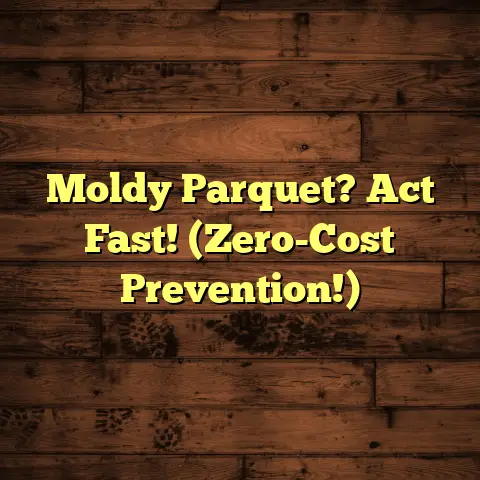Fix Cupping Floors Fast? (5 Pro Tips!)
Ever watched “Toy Story” and thought about Andy’s wooden floor? It’s where so much magic happens, right? But what if that floor was all warped and wonky?
That’s cupping, my friend, and it’s no fun!
Just like Woody and Buzz had to deal with unexpected challenges, we homeowners sometimes face the dreaded cupping floor. Don’t worry, I’m here to help you fix it!
Section 1: Understanding Cupping Floors
1. Definition and Causes
Cupping happens when the edges of your wood planks rise higher than the center. Imagine a gentle wave effect across your floor. It’s not a design choice, trust me!
What causes this?
The main culprit is moisture imbalance.
Think of it like this: the bottom of your floor is wetter than the top. The wood expands where it’s damp, pushing the edges up.
Common Causes:
-
Humidity Fluctuations: Wild swings in humidity can wreak havoc.
-
Water Damage: Leaks, spills, or even poor ventilation can lead to cupping.
-
Improper Installation: Sometimes, the subfloor wasn’t dry enough when the wood was installed.
It’s like in “The Wizard of Oz,” when Dorothy gets swept away by a tornado. You never see it coming! Moisture can be just as unpredictable.
2. Signs of Cupping
How do you know if you have cupping?
Here’s what to look for:
-
Visual Unevenness: The most obvious sign. Look across your floor at a low angle. Do the planks look like they’re curving upwards at the edges?
-
Raised Edges: Run your hand across the floor. Can you feel the edges of the planks sticking up?
-
Gaps: You might notice wider gaps between the boards than usual.
-
Sound: Sometimes, cupped floors can creak or groan when you walk on them.
Imagine you’re in a horror movie. You hear strange noises, things look off, but you ignore them. Don’t be that person! Pay attention to the signs before it gets too late.
Section 2: The Importance of Quick Action
1. Why Speed Matters
Why rush to fix cupping? Because it only gets worse!
Delaying repairs can lead to:
-
Worsening Damage: The longer the moisture imbalance persists, the more the wood will warp.
-
Mold Growth: Damp environments are breeding grounds for mold, which can be a health hazard.
-
Decreased Property Value: Cupped floors are a major turn-off for potential buyers.
Think of it like a ticking time bomb in an action movie. The longer you wait, the bigger the explosion (or in this case, the bigger the repair bill!).
Section 3: Pro Tip #1 – Identify the Source of Moisture
Okay, Sherlock Holmes time! You need to find out where the moisture is coming from.
Here’s how:
-
Check for Leaks: Look under sinks, around toilets, and near any plumbing. Use a moisture meter to check suspicious areas.
-
Inspect Your Foundation: Cracks in your foundation can let moisture in.
-
Assess Ventilation: Is your crawl space properly ventilated? Poor ventilation can trap moisture.
-
Look Outside: Check your gutters and downspouts. Are they directing water away from your foundation?
It’s like in any good detective show. You gather clues, follow the trail, and eventually, you find the culprit!
Section 4: Pro Tip #2 – Control Humidity Levels
Maintaining the right humidity is crucial. Think of it like Goldilocks and the Three Bears – you want it just right!
Optimal Humidity:
Ideally, you want to keep your home’s humidity between 30% and 50%.
How to Control Humidity:
-
Humidifiers: Use these in the winter when the air is dry.
-
Dehumidifiers: Use these in the summer or in damp environments.
-
Air Conditioning: AC helps remove moisture from the air.
-
Ventilation: Ensure proper ventilation in bathrooms and kitchens.
I recommend investing in a good hygrometer to monitor humidity levels. You can find these for around \$20-\$30.
It’s like finding balance in a chaotic sitcom. The characters have to work together to find equilibrium!
Section 5: Pro Tip #3 – Drying Out the Floors
Now that you’ve found the source of moisture and are controlling humidity, let’s dry out those floors!
Techniques:
-
Fans: Place fans strategically to circulate air.
-
Dehumidifiers: Run a dehumidifier in the affected area.
-
Heat: In some cases, gentle heat can help. Be careful not to overheat the wood.
-
Remove Obstructions: Take away rugs or furniture that might be trapping moisture.
This process can take time, depending on the severity of the cupping. Be patient!
Imagine you’re a hero in a disaster movie, rescuing people from a flood. You have to act quickly and efficiently to save the day!
Section 6: Pro Tip #4 – Sanding Down Cupped Floors
Sometimes, after drying, the cupping remains. That’s when sanding comes in.
When to Sand:
- After the floors have completely dried out.
- If the cupping is minor.
- If you’re comfortable with DIY projects.
Step-by-Step Sanding:
-
Safety First: Wear a dust mask, safety glasses, and ear protection.
-
Rent a Drum Sander: You can rent these from most hardware stores.
-
Start with Coarse Grit: Use a coarse-grit sandpaper (e.g., 36-grit) to remove the cupping.
-
Progress to Finer Grits: Gradually move to finer grits (e.g., 60-grit, 80-grit, 100-grit) to smooth the surface.
-
Sand Edges: Use an edge sander to reach the edges of the room.
-
Vacuum Thoroughly: Remove all dust before applying a finish.
-
Apply Finish: Apply several coats of polyurethane or another protective finish.
Safety Tips:
- Always sand with the grain of the wood.
- Keep the sander moving to avoid creating dips.
- Don’t apply too much pressure.
- Empty the dust bag frequently.
Sanding can be a bit like preparing for a high-stakes mission in an action film. Meticulous planning and execution are key!
Section 7: Pro Tip #5 – Seek Professional Help
Sometimes, DIY isn’t enough. Know when to call in the pros!
When to Call a Professional:
- If the cupping is severe.
- If you’re not comfortable sanding.
- If you suspect structural damage.
- If mold is present.
Finding a Good Contractor:
- Get recommendations from friends or family.
- Check online reviews.
- Get multiple quotes.
- Make sure they’re licensed and insured.
According to HomeAdvisor, the average cost to repair hardwood floors is between \$3 and \$8 per square foot.
It’s like when the Avengers team up to fight a supervillain. Some problems are just too big to handle alone!
Conclusion: Bringing it All Together
So, there you have it – my five pro tips for fixing cupping floors fast!
- Identify the Source of Moisture
- Control Humidity Levels
- Drying Out the Floors
- Sanding Down Cupped Floors
- Seek Professional Help
Remember, quick action is key! Don’t let cupping ruin your floors and your home.
Just like the characters in your favorite movies and TV shows, you can overcome any obstacle with determination and the right tools. So go out there and take charge of your flooring issues! You got this!





